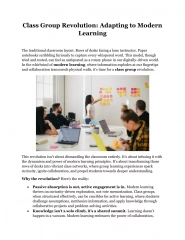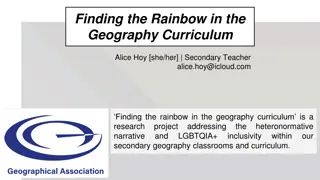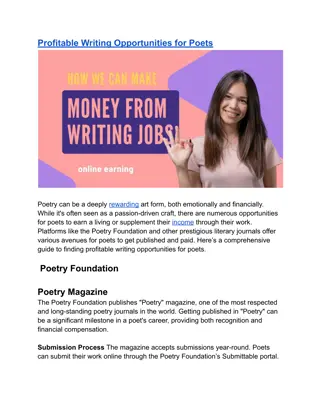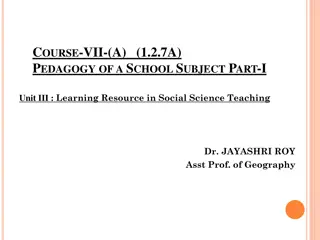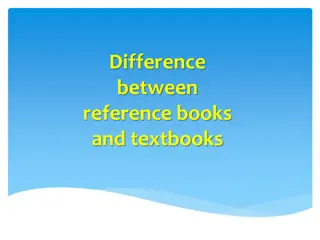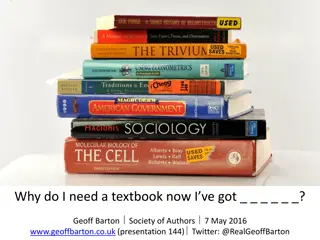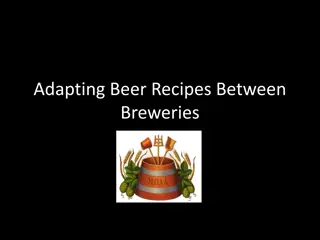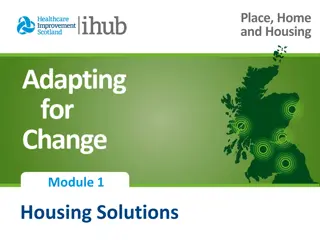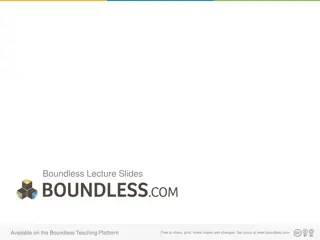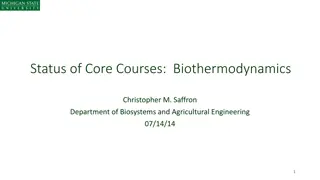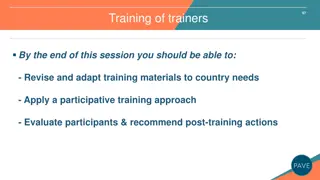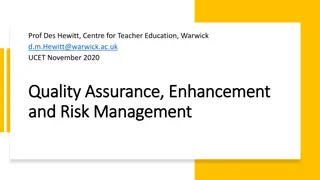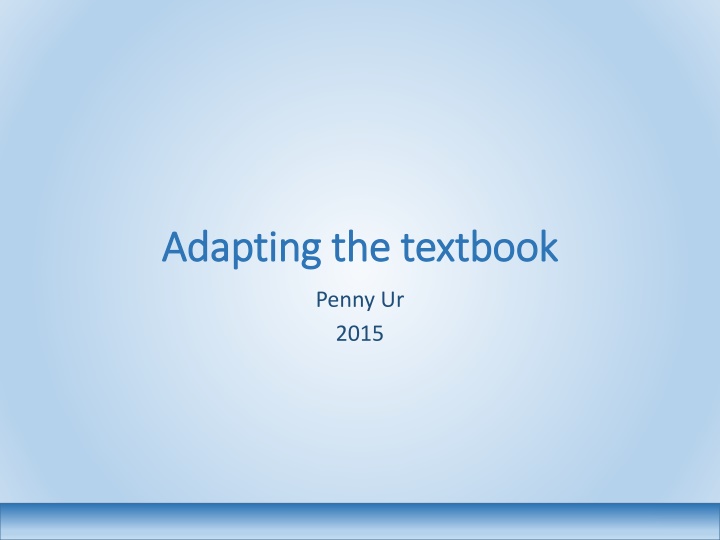
Adapting and Enhancing Teaching Materials for Effective Learning Strategies
Explore the concepts of adapting teaching materials for increased learning value, engagement, and variety. Learn how to modify presentation methods and tasks to suit different classroom scenarios. Discover strategies for adapting reading texts, grammar exercises, and vocabulary tasks for optimal student learning outcomes.
Download Presentation

Please find below an Image/Link to download the presentation.
The content on the website is provided AS IS for your information and personal use only. It may not be sold, licensed, or shared on other websites without obtaining consent from the author. If you encounter any issues during the download, it is possible that the publisher has removed the file from their server.
You are allowed to download the files provided on this website for personal or commercial use, subject to the condition that they are used lawfully. All files are the property of their respective owners.
The content on the website is provided AS IS for your information and personal use only. It may not be sold, licensed, or shared on other websites without obtaining consent from the author.
E N D
Presentation Transcript
Adapting Adapting the the textbook textbook Penny Ur 2015
Why adapt? Why adapt? To increase learning value To make more interesting To suit our own teaching style For the sake of variety For fun; because we feel like it! 2
How? How? We can write or find new texts or tasks But we don t have to. We can vary the way we treat textbook material without much further preparation 3
This presentation This presentation 1. Adapting reading texts 2. Adapting grammar and vocabulary exercises 4
Aspects that can be adapted Aspects that can be adapted 1. The way we present or mediate the text 2. The tasks we do on them 6
1. Presentation / Mediating 1. Presentation / Mediating Quantity: How many times will we read the text? Interaction pattern: full-class / individual / pair or group Reading technique: silent / aloud Quantity: all in one go / bit by bit. Place: in class / at home 7
a) Quantity a) Quantity Usually at least three times, in different ways. Why? Sometimes fewer? Why? 8
b b) ) Interaction pattern Interaction pattern First reading usually full-class (direct teacher support) an easy text: students can read individually, or help each other in pairs / groups Second / later readings individual / pair / full class 9
c) Silent or aloud c) Silent or aloud First reading Recommended: teacher reads aloud, students follow If easy: silent Don t ask students to read aloud new text Second / later readings Mostly silent (faster, easier) Rehearsed student reading ( Reader s Theater ) 10
d) Quantity d) Quantity If short, then all in one go If long then usually bit by bit BUT An exciting story? A relatively easy text? 11
e) Place e) Place First reading Usually in class (teacher support) Pre-read for homework? limited tasks. Later readings Some in class some at home How do you make sure they do the reading at home? 12
Comprehension tasks Comprehension tasks 1. Comprehension questions 2. Alternative tasks involving comprehension 13
Problems with comprehension Problems with comprehension questions 1 questions 1 They may not check comprehension 14
The text The changks voz blunging frewly nedeng the brudegan. Some changks vos unred, but the other changks vos unredder. They vos all polket and rather chiglop, so they did not mekle the spuler. A few were unstametick. The comprehension questions What were the changks doing? How were they blunging? Where were they blunging? In what ways were the changks the same and in what ways were they different? Were any changks unstametick?
What can you do about this? What can you do about this? Use different wording Ask students to answer about underlying meanings, not the actual text. 16
Example Example Mr Smith asked his wife for assistance, and she agreed. Bad question: Who did Mr Smith ask for assistance? Better questions: Who did Mr Smith get to help him? Was Mr Smith married? 17
Problems with comprehension Problems with comprehension questions 2 questions 2 They are boring. 18
What can we do about it? What can we do about it? Use a variety of tasks that involve comprehension Provided that these are ones that are quick and easy to prepare and do. 19
Shortening 20
Shorten the text Shorten the text Delete words from the text, without altering the basic meaning. (or phrases or full sentences) Summarize in English (with a specific word-limit) Summarize in L1. Do a Dicto-gloss Compose a new title (and subtitle). Make brief notes / headings. 21
Lengthening 22
Expand the text without altering the Expand the text without altering the basic meaning basic meaning Add single words / phrases/ Add sentences. Add margin notes (explanations, comments). Add an ending/ continuation. Add a preface. 23
Comparison 24
Compare this text with another Compare this text with another Compare this text to one we ve studied before. OR Compare two texts in the same unit. What are some differences in general? What are some similarities in general? Or: Compare specific aspects: - the main characters (in stories) - the structure of the text 25
Selection 26
Select bits out of the text Select bits out of the text Choose the most important sentence in the text. Choose the ten words and phrases that are most essential for understanding the main message. Find all the words that relate to (a topic). Find the sentence the teacher reads out. Find the sentence whose translation the teacher reads out. 27
Represent in some other format or Represent in some other format or style style Translate. Rewrite in simple English for a less advanced learner. Convert to a power-point presentation. Imagine the text is a book: draw a cover illustration. Rewrite as a different genre (as an email, a poem, a newspaper report ). Write in a different style (very informal or very formal). 29
Respond to the text in some personal Respond to the text in some personal way way Say what you admire, or dislike, about a character (in a story) What would you like to say to a character in the story? What does the text remind you of, from your own experience? What would you like to ask the author? 31
2. Grammar and vocabulary exercises 32
Main Main aims aims 1. To increase quantity of learning 2. To add interest and enjoyment (for students and teacher) 3. To create learning opportunities for different levels: individualization 33
The techniques The techniques 1. Change interaction type (frontal? group? individual?) 2. Change instructions 3. Delete bits in order to add more open- ended responses 4. Personalize 5. Recycle in different ways 6. Add, extend, vary 34
Change interaction type Change interaction type Normally: IRF Other possibilities: Do it individually, then quick check Individually, then share, then check Do it in pairs, then quick check Do for homework, then quick check 35
Change instructions Change instructions First: Read quietly through the exercise, or read through with the teacher, without actually doing it. Then: Do at least seven items, more if you can Do as much as you can in X minutes Start wherever you like Do whichever five items you like (then more, if you finish) 36
Delete bits to open Delete bits to open- -end end Can be done mainly with gapfills But also with matching exercises and multiple- choice The result: more learning, more interesting, more individualized. 37
Personalize Personalize Ask student to alter (some of) the sentences to make ones that are true for them. 38
Recycle in different ways Recycle in different ways 1. We ve done it orally in class: now do it for homework and get it all right! 2. Simply do again a week later in class: can you get them all right? 3. Immediately after: close your books. How many of the items can you recall from memory? (Full-class brainstorm; or individual then sharing then full class) 4. Redo in any of the ways we ve already mentioned (open-ended, personalized etc.). 39
Add / Extend / Vary Add / Extend / Vary 1. Add more items to the ones we already have in the exercise. 2. Suggest more words or phrases that could be added to the item: at the end? in the middle? at the beginning? anywhere? 3. Suggest words that might be changed 40
In general In general We ll often do the exercise as it stands first, then introduce a variation. But always just to do as it stands is to miss opportunities for more learning, more interest, more fun 41
Dont just let the textbook use you! YOU use the textbook For YOUR teaching, for YOUR students. 42
Thank you for your attention! pennyur@gmail.com 43
Circle the correct answers 1. I like my room to be a. honest 2. My father drinks milk that s only one .. He s on a diet. a. manager b. customer 3. We are . Beyonc s music. We listen to it all the time. a. crazy about b. ashamed of 4. Ben s father works in a that makes cars. a. factory b. library 5. It was a nice day so we to go on a picnic. a. ignored b. realized 6. My mother every month. a. takes a wrong turn b. pays the bills c. gets on my nerves b. neat and tidy c. patient c. percent c. worried about c. headline c. decided Navigator Practice Book p.28 44
Circle the correct answers 1. I like my room to be a. honest 2. My father drinks milk that s only one .. He s on a diet. a. manager b. customer 3. We are . Beyonc s music. We listen to it all the time. a. crazy about b. ashamed of 4. Ben s father works in a that makes cars. a. factory b. library 5. It was a nice day so we to go on a picnic. a. ignored b. realized 6. My mother every month. a. takes a wrong turn b. pays the bills c. gets on my nerves b. neat and tidy c. patient c. percent c. worried about c. headline c. decided Navigator Practice Book p.28 45
My ideas My ideas Choose one of the wrong options, and make it right (i.e. invent a sentence where it would be the right answer) e.g. 1. I like my friends to be honest Change each stem , (add, change, or delete a word). e.g. 2. We are all crazy about Change the sentences so it s true about you or someone you know. e.g. 3. I drink milk that is 3 per cent, I m not on a diet. Delete everything after the first 3-4-5 words, finish any way you like. e.g. 4. Ben s father works in an office Invent new sentences (true for you) that contextualize any of the items in the options e.g. 5. I decided to visit my grandmother yesterday. 46
Choose the word which is closest in meaning to the word in bold 1. commitment a. promise b. competition 2. positive a. optimistic 3. education a. experiment b. learning 4. role a. job b. topic 5. individual a. people 6. opportunity a. chance 7. society a. customer 8. service a. help b. hear That s Right (Practice book, p.51) b. possible b. person b. door b. community 47
Choose the word which is closest in meaning to the word in bold 1. utilize a. use b. over-exploit 2. opt a. be optimistic 3. competence a. income b. ability 4. restrict a. limit b. be strict 5. mandatory a. compulsory b. command 6. severe a. cutting 7. deteriorate a. get better 8. straightforward a. simple That s Right (Practice book, p.51) b. choose b. very bad b. get worse b. ahead 48
Complete the table Base form Past simple Base form Past simple 1. get got 7. reply 2. know 8. eat 3. make 9. borrow 4. love 10. carry 5. buy 11. manage 6. deliver 12. take Navigator Practice Book p.20 49
Complete the phrases point healthy food better done a bike late change water bottle cover do sports the weekend good 1. You must _________. 2. Don t forget a _________. 3. You need to _________. 4. You should eat _________. 5. not so _________! 6. Eat _________. 7. Enjoy _________. 8. Well _________! 9. ride _________. 10. sleep _________. 11. one _________ 12. a book _________. Cool Workbook p.67 50

